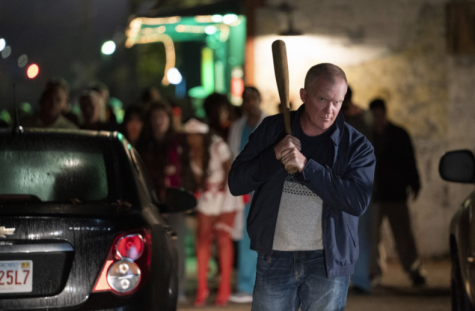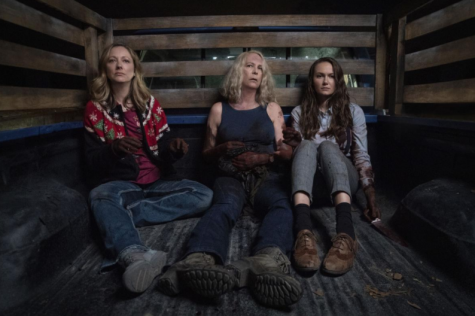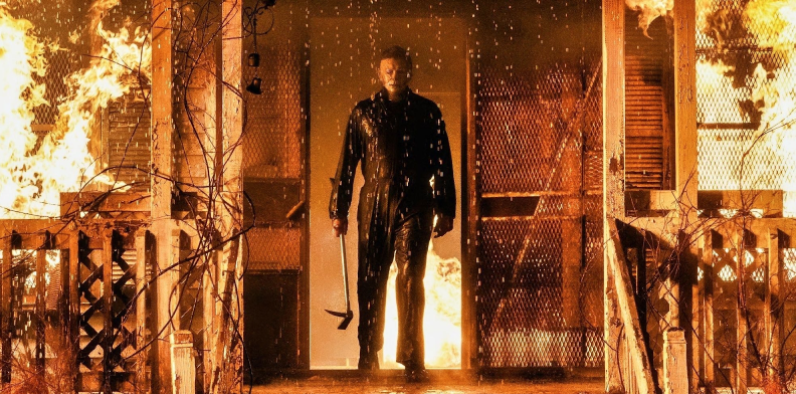‘Halloween Kills’ represents the death of America’s most beloved ‘Halloween’ franchise
The latest installment of the “Halloween” franchise fails to live up to its predecessor
Michael Myers (James Jude Courtney) stands in front of a burning house in the film’s opening scene. Photo courtesy of Universal Pictures
October 26, 2021
Released on Oct. 15, the long anticipated slasher film “Halloween Kills” made its debut on the big screen. Directed by renowned filmmaker David Gordon Green, this film is the 12th installment in the 43-year-old “Halloween” franchise. Unfortunately, despite the success of 2018’s “Halloween,” “Halloween Kills” proves to be a convoluted and disappointing mess of confusing horror cliches.
The movie follows serial killer Michael Myers (played by James Jude Courtney) as he wreaks havoc in the sleepy town of Haddonfield, Illinois. There, Myers engages in a sadistic game of cat-and-mouse as he hunts Karen and Allyson (played by Judy Greer and Andi Matichak), the daughter and granddaughter to the original “Halloween” protagonist Laurie Strode. Along with Tommy Doyle (played by Anthony Michael Hall) and his vigilante mob of Haddonfield residents, the characters struggle to survive against the seemingly unkillable Myers.

The film picks up directly after the events of 2018’s “Halloween” reboot, with Myers escaping from the charred remains of Laurie’s safe room and proceeding to massacre the townspeople. Unfortunately, this opening sequence kills all suspense of Myers sustaining lasting damage from the previous movie, in which he was buried under rubble from a burning building after his violent showdown with Laurie Strode. The cinematic trope of kitchen knives and persisting evil leaves Myers’s character devoid of any real terrifying qualities.
The movie continues its use of true horror movie cliches when the Haddonfield residents make the foolish decision to try and hunt down Michael Myers, resulting in their unsurprisingly gruesome deaths. Chanting “evil dies tonight,” the mob, in a comical and even ridiculous plot twist, ends up accidentally chasing Lance Tovoli (played by Ross Bacon), a random fugitive mistaken for Myers. The bizarre decision renders the movie’s realism almost nonexistent as the townspeople attempt to kill a knowingly undefeatable antagonist.
Perhaps even more dismaying was the underutilization of Laurie Strode (played by Jaimie Lee Curtis). Confined to a hospital bed, Strode is relegated to the backseat as the bulk of the movie features her less-experienced granddaughter Allyson.

The movie’s redeeming factors appeared sparsely throughout the story. Classic horror scares hit their marks at certain points in the film including Myers emerging from a house fire or bloody masks being placed on the faces of Myers’ victims. Another redeeming quality is the dramatization of certain scenes, including Myers’ murder of an elderly couple. Following the killing, Myers diabolically props up their bodies in the same pose as a photo on their mantle, while listening to “Can I Have This Dance for the Rest of My Life?” by Anne Murray.
Overall, a combination of the convoluted plot, constant cliches and simple lack of abject terror cements “Halloween Kills” as a disappointing continuation of a dragging franchise. Unlike “Halloween,” which provided unique plot twists and bold cinematic features, “Halloween Kills” fails to go beyond anything more than the age-old horror storyline. In the latest installment of the “Halloween” franchise, it seems that the only thing that has been killed is Michael Myers’ legacy as a staple horror brand.
Rating: ⅖ stars




























